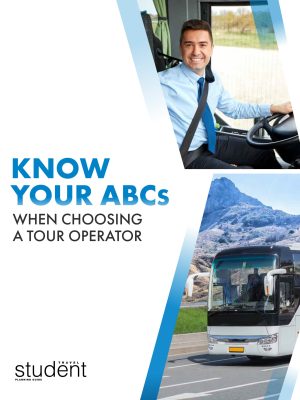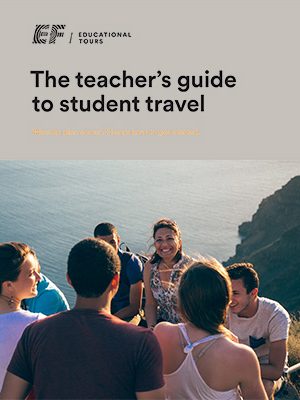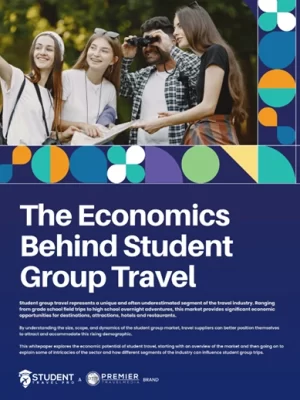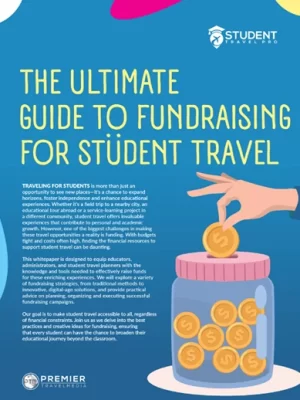Learn how to plan and execute inclusive trips for students with disabilities. Explore ADA guidelines, logistical tips, and best practices for safe travel.
Accessibility matters; every student deserves opportunities to explore the world through engaging educational travel, regardless of their limitations. Recent studies conclude that 32% of parents reported their child missing a field trip due to a disability. In comparison, 21% said their child’s physical limitations prevented them from full participation in school trips. The good news is that in recent years, many establishments in the US, including museums and learning centers, have taken significant steps to revitalize their experiences to be inclusive for everyone.
However, what does this mean for students with disabilities, and how does it impact the future of accessible educational travel?
Stay ahead of the curve—get fresh trip ideas when you join our newsletter.
Understanding Accessibility Requirements
Disabilities come in many forms, some of which are noticeable, while others are less apparent, including physical, cognitive, emotional, mental, learning, and chronic health conditions. Legal frameworks have been in place in the US for decades, ensuring equality and prohibiting discrimination against those with limited abilities. Let’s break them down and better understand how they impact educational travel and students with disabilities.

ADA-compliant facilities will have handicap parking with clearly marked spaces. Photo credit: Freepik
Americans with Disabilities Act (ADA)
The Americans with Disabilities Act (ADA) was introduced in 1990 as a landmark civil rights law that forbids discrimination against people with disabilities in all areas of community life, from schools, transportation and open spaces, to museums, galleries, hotels, and other public institutions. For students, this ensures that shared areas experienced during field trips comply with the law, including barrier-free facilities, provisions for wheelchair access and accommodation for individuals with hearing and visual impairments.
Individuals with Disabilities Education Act (IDEA)
Becoming law in 1975 and revised numerous times, the Individuals with Disabilities Education Act (IDEA) requires all public schools to accommodate eligible children with disabilities to a free and appropriate public education (FAPE). For schools, this means providing equal access to educational activities, including field trips, to students with disabilities.
Every Student Succeeds Act (ESSA)
In 2015, the Every Student Succeeds Act (ESSA) replaced the No Child Left Behind law. It ensures equal educational opportunities for all students and encourages inclusive learning environments, such as field trip experiences, to promote accessible education outside the classroom.

Accessible travel leads to inclusive opportunities to participate in field trips. Photo credit: Freepik
Preparing an Accessibility Plan
Begin your planning process by identifying key needs for traveling students with disabilities. Collaborate with parents, school counselors and Individualized Education Program (IEP) administrators for insights to understand the necessary inclusions. Establish a clear and detailed accessibility plan outlining specific transportation needs, mobility assistance, medical or behavioral support protocols, dietary requirements, and other special accommodations for safety, accessibility and comfort.
Planning a student adventure? Let our expert-curated resources lead the way.

Boston Children’s Museum celebrates Disability Pride Month in July. Photo credit: Boston Children’s Museum Facebook
Choosing the Ideal Destination & Accommodation
Ensure that the establishments you plan to visit are ADA-compliant with a reputation for inclusivity and accessibility. These venues will have clear visual and tactile signage posted, designated quiet areas for sensory-sensitive visitors, trained support staff for those with diverse needs, and accessibility statements noted where appropriate. Many field trip locations, including science centers, art establishments, museums, and national parks, provide ASL-interpreted tours, wheelchair rentals and sensory-friendly hours for accessible educational adventures and inclusivity. Search for disability-friendly tours and guided experiences to allow everyone to immerse themselves in learning.

Ensure safe transportation equipment before departing. Photo credit: Freepik
Travel Logistics & Safety Considerations
Transportation is the number one consideration when planning an accessible field trip. To ensure smooth transitions between destinations, maintain that all vehicles, including charter buses, air travel and public transportation, are wheelchair accessible and provide adequate space for storing assistive equipment. Boarding procedures, seating arrangements and restroom access should be considered before traveling. It’s essential to incorporate extra time into your itinerary to account for longer stops to accommodate students with disabilities. An emergency plan should be outlined and clearly communicated to students, parents, chaperones, and other adult attendants. This should include medical emergency protocols, support contacts, and other necessary student medical information.

Community fundraisers are a great idea to help fund field trips. Photo credit: Freepik
Budgeting & Funding for Accessible Trips
Regardless of the level of care your students might need during a field trip, there will be added costs. It’s essential to account for personal aides, additional support staff, medical equipment, and specialized transportation. Consider grants and funding specifically available for student travel, typically offered through local school districts, educational nonprofits and disability advocacy organizations. Fundraisers are a fantastic way to rally the community for a great cause while securing funds towards student travel and raising awareness. Look into whether a destination offers group discounts or supports funding efforts for accessibility-related ventures.

Work together and craft a detailed plan outlining everyone’s roles and responsibilities to ensure all students with disabilities have a safe and enjoyable field trip. Photo credit: Freepik
Collaborating with Chaperones & Support Staff
It’s vital to bring on board professional trip leaders who are first aid certified and experienced in traveling with people with disabilities. Offer additional support with training sessions and workshops on disability awareness and proper emergency procedures for those without experience. Provide a detailed list of roles and responsibilities for each chaperone and outline expectations in advance. A buddy system fosters inclusion and empathy. Pair students with others familiar with their needs to help with safety and comfort during the trip.
Tips for Positive Student Experiences
- Use person-first language to celebrate diversity in students’ abilities rather than recognizing them for their disabilities. Examples include a “person who uses a wheelchair” rather than a “wheelchair-bound person” or a “student with a disability” instead of a “disabled student.”
- Keep open and respectful communication between everyone attending the field trip, from adults to students.
- Allow students to participate at their own pace and comfort level.
- Ensure multi-sensory learning opportunities are available to support all students.
- Post-trip reflection sessions with your class will reinforce educational values and the importance of inclusivity and accessibility.
Why Accessible Travel Matters for Students With Disabilities
Accessible travel fosters compassion and empathy in individuals, raises community awareness, and allows students with disabilities to engage in educational opportunities alongside their peers. Transform your students’ lives with unforgettable learning adventures that align with curriculum standards and provide everyone with a traversable landscape for academic exploration.
By Heather Dale, Managing Editor
Discover safety tips, sample trips, and planning tools inside the Student Travel Planning Guide.










